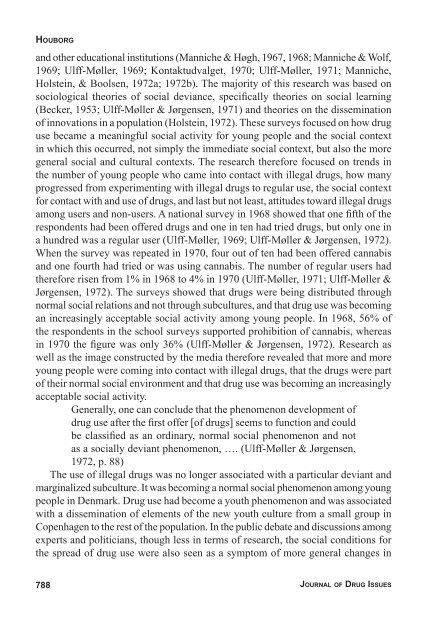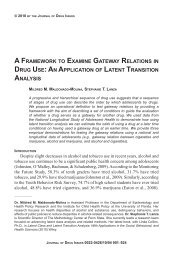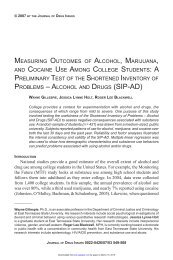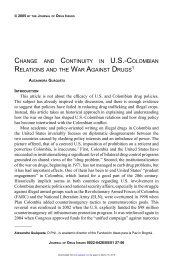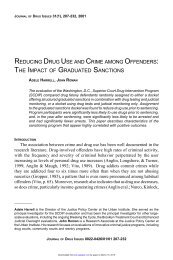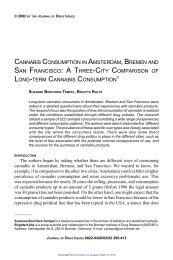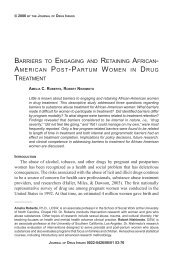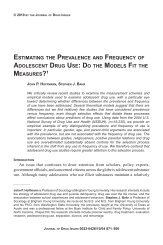control and welfare in danish drug policy - Journal of Drug Issues
control and welfare in danish drug policy - Journal of Drug Issues
control and welfare in danish drug policy - Journal of Drug Issues
Create successful ePaper yourself
Turn your PDF publications into a flip-book with our unique Google optimized e-Paper software.
HOUBORG<strong>and</strong> other educational <strong>in</strong>stitutions (Manniche & Høgh, 1967, 1968; Manniche & Wolf,1969; Ulff-Møller, 1969; Kontaktudvalget, 1970; Ulff-Møller, 1971; Manniche,Holste<strong>in</strong>, & Boolsen, 1972a; 1972b). The majority <strong>of</strong> this research was based onsociological theories <strong>of</strong> social deviance, specifically theories on social learn<strong>in</strong>g(Becker, 1953; Ulff-Møller & Jørgensen, 1971) <strong>and</strong> theories on the dissem<strong>in</strong>ation<strong>of</strong> <strong>in</strong>novations <strong>in</strong> a population (Holste<strong>in</strong>, 1972). These surveys focused on how <strong>drug</strong>use became a mean<strong>in</strong>gful social activity for young people <strong>and</strong> the social context<strong>in</strong> which this occurred, not simply the immediate social context, but also the moregeneral social <strong>and</strong> cultural contexts. The research therefore focused on trends <strong>in</strong>the number <strong>of</strong> young people who came <strong>in</strong>to contact with illegal <strong>drug</strong>s, how manyprogressed from experiment<strong>in</strong>g with illegal <strong>drug</strong>s to regular use, the social contextfor contact with <strong>and</strong> use <strong>of</strong> <strong>drug</strong>s, <strong>and</strong> last but not least, attitudes toward illegal <strong>drug</strong>samong users <strong>and</strong> non-users. A national survey <strong>in</strong> 1968 showed that one fifth <strong>of</strong> therespondents had been <strong>of</strong>fered <strong>drug</strong>s <strong>and</strong> one <strong>in</strong> ten had tried <strong>drug</strong>s, but only one <strong>in</strong>a hundred was a regular user (Ulff-Møller, 1969; Ulff-Møller & Jørgensen, 1972).When the survey was repeated <strong>in</strong> 1970, four out <strong>of</strong> ten had been <strong>of</strong>fered cannabis<strong>and</strong> one fourth had tried or was us<strong>in</strong>g cannabis. The number <strong>of</strong> regular users hadtherefore risen from 1% <strong>in</strong> 1968 to 4% <strong>in</strong> 1970 (Ulff-Møller, 1971; Ulff-Møller &Jørgensen, 1972). The surveys showed that <strong>drug</strong>s were be<strong>in</strong>g distributed throughnormal social relations <strong>and</strong> not through subcultures, <strong>and</strong> that <strong>drug</strong> use was becom<strong>in</strong>gan <strong>in</strong>creas<strong>in</strong>gly acceptable social activity among young people. In 1968, 56% <strong>of</strong>the respondents <strong>in</strong> the school surveys supported prohibition <strong>of</strong> cannabis, whereas<strong>in</strong> 1970 the figure was only 36% (Ulff-Møller & Jørgensen, 1972). Research aswell as the image constructed by the media therefore revealed that more <strong>and</strong> moreyoung people were com<strong>in</strong>g <strong>in</strong>to contact with illegal <strong>drug</strong>s, that the <strong>drug</strong>s were part<strong>of</strong> their normal social environment <strong>and</strong> that <strong>drug</strong> use was becom<strong>in</strong>g an <strong>in</strong>creas<strong>in</strong>glyacceptable social activity.Generally, one can conclude that the phenomenon development <strong>of</strong><strong>drug</strong> use after the first <strong>of</strong>fer [<strong>of</strong> <strong>drug</strong>s] seems to function <strong>and</strong> couldbe classified as an ord<strong>in</strong>ary, normal social phenomenon <strong>and</strong> notas a socially deviant phenomenon, …. (Ulff-Møller & Jørgensen,1972, p. 88)The use <strong>of</strong> illegal <strong>drug</strong>s was no longer associated with a particular deviant <strong>and</strong>marg<strong>in</strong>alized subculture. It was becom<strong>in</strong>g a normal social phenomenon among youngpeople <strong>in</strong> Denmark. <strong>Drug</strong> use had become a youth phenomenon <strong>and</strong> was associatedwith a dissem<strong>in</strong>ation <strong>of</strong> elements <strong>of</strong> the new youth culture from a small group <strong>in</strong>Copenhagen to the rest <strong>of</strong> the population. In the public debate <strong>and</strong> discussions amongexperts <strong>and</strong> politicians, though less <strong>in</strong> terms <strong>of</strong> research, the social conditions forthe spread <strong>of</strong> <strong>drug</strong> use were also seen as a symptom <strong>of</strong> more general changes <strong>in</strong>788 JOURNAL OF DRUG ISSUES


